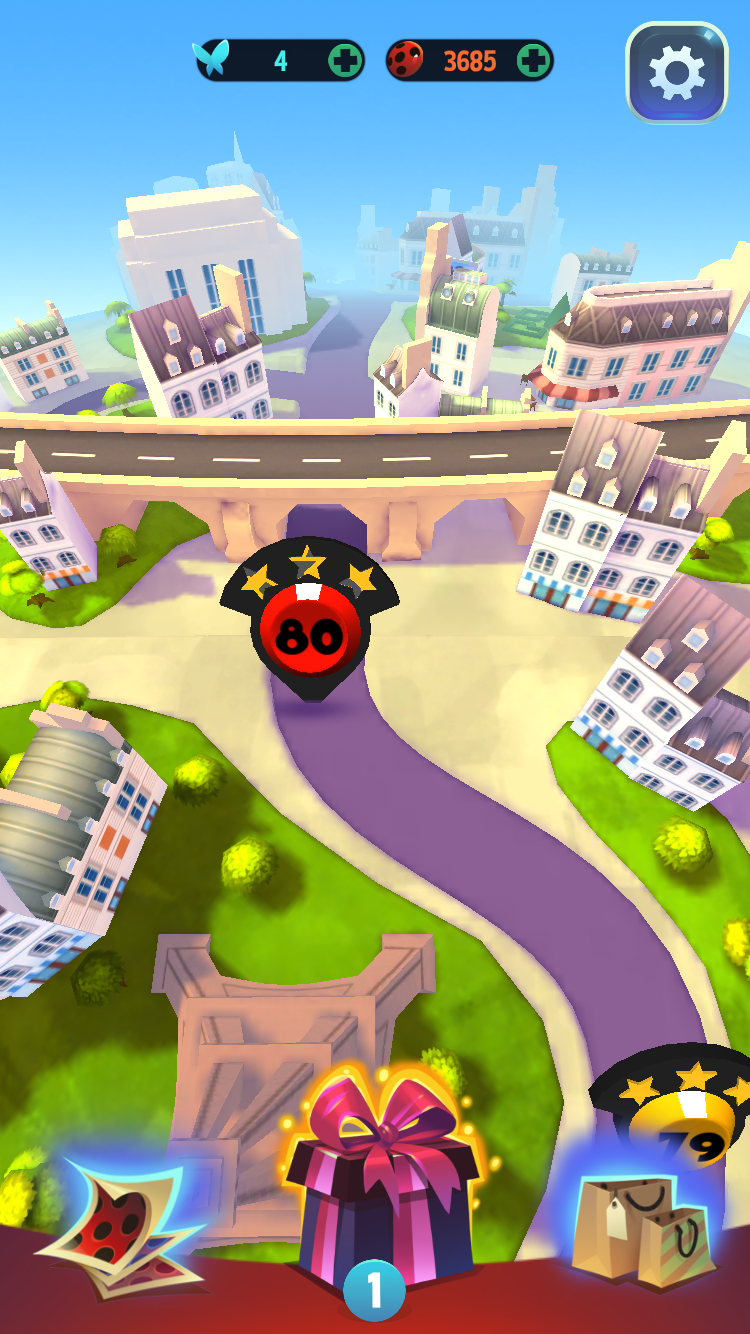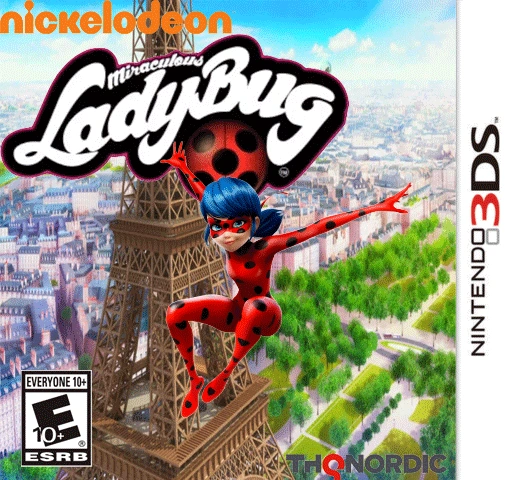Ladybug Game On
- Ladybug Game Online
- Ladybug Game On Youtube
- Ladybug Game On Roblox
- Ladybug Preschool Game
- Ladybug Game For Cats
Lady Bug and Cat Noir games are created mainly for girls, as most of the plots are about dating and relationships. But there are also arcades, puzzles, action games that boys will love too. You mainly need to play as Lady Bug, but in some games she is joined by her partner Cat Noir, who is also called Super Cat. Buy The Ladybug Game at Michaels.com. A bountiful garden of fun and learning beckons. The Ladybug Game is a kid-created marvel that invites your youngsters to join Ella Yellow, Rickie Red, and the others in a reading and counting adventure! Jun 06, 2020 The two Disney Channel superheroes are going to be the main characters in this new adventure challenge, and you will have to make sure that as fast as possible, you will be able to help Ladybug and Cat Noir be the best superheroes. You can see that the main controls of the game will be the mouse or the ARROW keys to make the Disney superheroes.

All the sessions from Transform 2021 are available on-demand now. Watch now.
Israeli game studio Toya has teamed up with Zag Games to create a new game for Roblox: Miraculous Ladybug & Cat Noir.
The game is based on the animated TV series Miraculous: Tales of Ladybug & Cat Noir, which targets girls ages 6 to 12 as well as boys ages 4 to 7.
Zag produces the show (along with On Kids & Family), and it will co-develop the game with publisher and developer Toya, a Tel Aviv-based game company that targets games for girls on the Roblox platform, which has more than 150 million monthly active users. Roblox itself is teed up for a public offering, as it recently raised $520 million on a $29.5 billion valuation.
The story is about two typical teens with secret identities, Marinette and Adrien, who can transform into the superheroes Ladybug and Cat Noir when evil threatens Paris.
Webinar
Three top investment pros open up about what it takes to get your video game funded.
Watch On Demand| Lady Bug | |
|---|---|
| Developer(s) | Universal |
| Publisher(s) | Arcade
Taito |
| Designer(s) | Kazutoshi Ueda[2] |
| Platform(s) | Arcade, ColecoVision, Intellivision |
| Release | |
| Genre(s) | Maze, Strategy |
| Mode(s) | Up to 2 players, alternating turns |
Lady Bug[a] is a maze chasevideo game produced by Universal and released for arcades in 1981.[1] Its gameplay is similar to Pac-Man, with the primary addition to the formula being gates that change the layout of the maze when used, adding an element of strategy to the genre. The arcade original was relatively obscure, but the game found wider recognition and success as a launch title for the ColecoVision console.[4]
Ladybug Game Online
Gameplay[edit]
The goal of Lady Bug is to eat all 'flowers,' hearts, and letters in the maze while avoiding other insects. The player is represented by a red, yellow, and green character resembling a ladybug while the enemy insects' appearance varies by level. The border of the maze acts as timer, with each circuit signaling the release of an enemy insect from the central area, up to (generally) a maximum of four. The speed of the circuit increases on stages 2 and 5.
There are eight different enemy insects — a different insect is introduced on each of the first eight levels. Beginning on level 9, each level has four different enemies.
Unlike Pac-Man, the player can alter the layout of the maze by shifting any of the twenty green gates. It is not possible to completely isolate a portion of the maze through gate-shifting.
Ladybug Game On Youtube
When the fourth enemy insect enters the maze, the central area will show a level-specific vegetable. Eating a vegetable gives the player bonus points and immobilizes the enemy insects for several seconds, though touching them is still lethal. The randomly placed skull icons are lethal to ladybugs and enemy insects. An enemy insect who dies returns to the central area. Once a vegetable is eaten, the central area will remain empty unless an enemy insect dies and is re-released, revealing a new vegetable. A ladybug who dies will shrink from view and be briefly replaced with icons resembling the stereotypical wings and halo of an angel.
The colors of the hearts and letters cycle through a short red, a middling yellow, and a longer blue. The point values are as follows:
- Flower: 10 points (20, 30, or 50 points with appropriate multiplier)
- Blue letter/heart: 100 points (200, 300, or 500 points with appropriate multiplier)
- Yellow letter/heart: 300 points (600, 900, or 1500 points with appropriate multiplier)
- Red letter/heart: 800 points (1600, 2400, or 4000 points with appropriate multiplier)
- Vegetable: Starts at 1000 points, increases by 500 with each level to a maximum of 9500 points on level 18. Beyond this level, the vegetable's appearance (horseradish) and point value remain fixed.
If a heart is consumed while it is blue, a point multiplier will come into effect, indicated by the blue section in the upper right corner of the screen. The first blue heart doubles all point values, the second triples them and the third quintuples them. This multiplier lasts until the level is complete. Eating hearts while they are yellow or red offers no benefit beyond the points collected.
At each level, the maze will contain three letters. The first will be randomly selected from the set of {X, T, R} (which appear only in EXTRA), the second will be randomly selected from the set of {S, P, C, I, L} (which appear only in SPECIAL), and the third will be an A or an E (which appear in both words). A secondary goal of the player is to complete the words SPECIAL (indicated in red in the top left corner) and EXTRA (in yellow at top center). If, for example, a letter S is consumed while it is red, the corresponding letter in the word SPECIAL will change from grey to red. Eating an S while it is any other color (or if the S in SPECIAL is already red) offers no benefit beyond the points collected. Completing the word SPECIAL rewards the player with a free game, while completing EXTRA gives the player an extra life. Completing either word causes all its letters to return to normal and immediately advances the player to the next level.

The vegetables associated with the first 18 levels and their corresponding point values are: 1 - cucumber (1000), 2 - eggplant (1500), 3 - carrot (2000), 4 - radish (2500), 5 - parsley (3000), 6 - tomato (3500), 7 - pumpkin (4000), 8 - bamboo shoot (4500), 9 - Japanese radish (5000), 10 - mushroom (5500), 11 - potato (6000), 12 - onion (6500), 13 - Chinese cabbage (7000), 14 - turnip (7500), 15 - red peper (8000) [note that the name is misspelled in the game], 16 - celery (8500), 17 - sweet potato (9000), 18 - horseradish (9500).
The melody that plays when a new Lady Bug enters the maze is a snippet of a song called 'Ladybug Samba'.
Ports[edit]
Lady Bug was adapted to the home video game systems Intellivision and ColecoVision. In the ColecoVision version, completing SPECIAL puts the player into a bonus level (known in-game as a 'Vegetable Harvest') where the goal is to consume as many randomly placed vegetables as possible within a fixed time. The SPECIAL register does not appear in the Intellivision version. In 1982, a catalog of Atari 2600 cartridges manufactured by Coleco said that an Atari 2600 version of Lady Bug would be released, but Coleco never released the game.[citation needed]
Reception[edit]
Ladybug Game On Roblox
According to Electronic Games. Lady Bug did 'just all right in the arcades' but became popular when it was released as a home video game cartridge. They said the ColecoVision port is 'proving to be one of the most successful home videogames ever.'[4]
The arcade game was recognized for its originality within the maze game genre. In January 1983, the fourth Arcade Awards gave it a Certificate of Merit as runner-up for Most Innovative Coin-Op Game, stating that the 'addition of turnstiles to the labyrinth' made the game 'a fascinating contest packed with strategic nuances never before equalled in this particular genre of coin-op.'[5]Electronic Games called it 'the most wonderful blend of strategy and maze-chase thrills ever concocted.'[4]

Reviewing the ColecoVision version, Creative Computing Video & Arcade Games said in 1983 that Lady Bug was not a Pac-Man clone, stating that the movable turnstiles 'set it apart from all other maze games'. The magazine reported that the ColecoVision version had become more popular than the arcade game at its office.[6] It was reviewed in Video magazine in its 'Arcade Alley' column where it was described as 'a maze-chase game with all the high-speed action and thrills of Pac-Man combined with strategy-oriented play and pinball-style bonus features'. The game's sound and graphics were reported to 'equal, if not actually surpass, the original', and the reviewers particularly emphasized the innovative use of 'color sequencing and the revolving turnstiles'. The most significant criticism offered was that 'the movement control is stiff and somewhat jerky'.[7] This version of the game was popular,[4] winning the Videogame of the Year award in the '16K or more ROM' category at the 5th annual Arkie Awards where the judges described it as an 'outstanding home edition of a coin-op-palace cult favorite'.[8]:40 The game has received appreciation in later years, being praised by some as 'the most challenging of the Pac-clones... It was, and still is, one of the best [of the clones].'[9]
Legacy[edit]
Doodle Bug is a 1982 clone for the TRS-80 Color Computer.[10]Bumble Bee replaces the main character with a bumblebee and the enemies with spiders; it was released in 1983 and 1984 by Micro Power for the BBC Micro, Acorn Electron, and Commodore 64.
See also[edit]
- Mouse Trap (1981)
- Drelbs (1983)
Notes[edit]
References[edit]
Ladybug Preschool Game


- ^ abcd'Overseas Readers Column - Universal 'Lady Bug' Worldwide Sales Begin'(PDF). Game Machine (in Japanese). No. 179. Amusement Press, Inc. 15 December 1981. p. 30.
- ^Masuda, Atsushi (3 January 2018). '『Mr.Do!』の生みの親、上田和敏氏に開発秘話を聞く!~『Mr.Do!』対談編 前編~'. AKIBA PC Hotline! (in Japanese). Impress Corporation. Archived from the original on 2019-12-08. Retrieved 2020-08-23. (Translation by Source Gaming. Archived 2020-08-23 at the Wayback Machine).
- ^Akagi, Masumi (13 October 2006). アーケードTVゲームリスト国内•海外編(1971-2005) [Arcade TV Game List: Domestic • Overseas Edition (1971-2005)] (in Japanese). Japan: Amusement News Agency. p. 15. ISBN978-4990251215.
- ^ abcdPearl, Rick (June 1983). 'Closet Classics'. Electronic Games. Vol. 1 no. 16. pp. 82–9.
- ^'1983 Arcade Awards: Most Innovative Coin-Op Game'. Electronic Games. Vol. 1 no. 11. January 1983. p. 36.
- ^Linzmayer, Owen (Spring 1983). 'Home Video Games: Colecovision: Alive With Five'. Creative Computing Video & Arcade Games. p. 50.
- ^Kunkel, Bill; Katz, Arnie (January 1983). 'Arcade Alley: Smurf & Ladybug from ColecoVision'. Video. Reese Communications. 6 (10): 50, 122. ISSN0147-8907.
- ^Kunkel, Bill; Katz, Arnie (January 1984). 'Arcade Alley: The Arcade Awards, Part 1'. Video. Reese Communications. 7 (10): 40–42. ISSN0147-8907.
- ^Jonah Falcon. 'GOTW: Ladybug'. GameSpy. Archived from the original on December 1, 2013.
- ^Boyle, L. Curtis. 'Doodle Bug'. Tandy Color Computer Games.
External links[edit]
- Lady Bug at the Killer List of Videogames